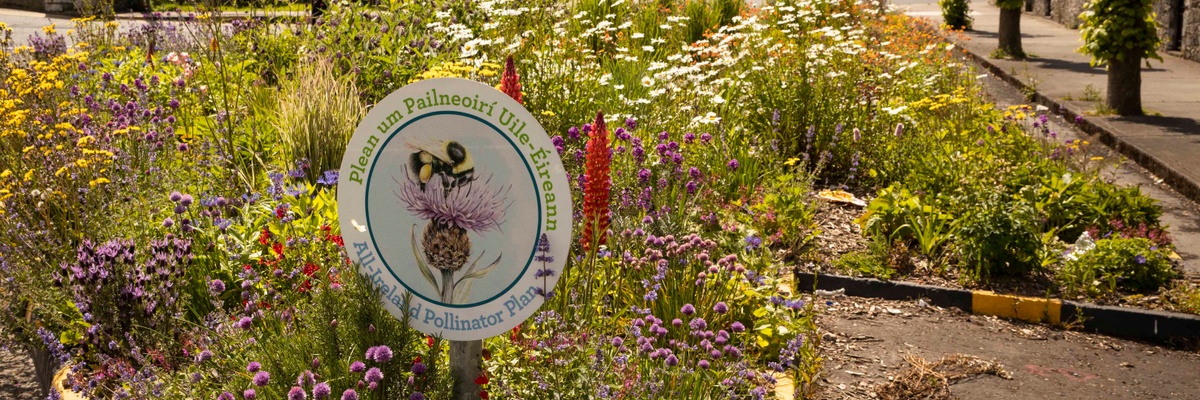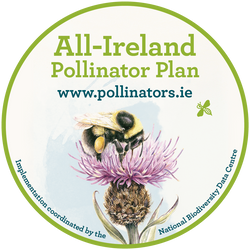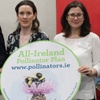Reduce Mowing
Most local communities will already have some areas that are very good for pollinators and are acting as refuges. The most important thing you can do is recogise and protect these.
Protect existing sources of food and shelter for pollinators.
Signage can be used to identify to the public areas within the local community that are important for pollinators.
Let the dandelions bloom
Identify areas that will be mown under existing regimes, but aim to carry out the first grass cut of the year in April after the first flush of dandelions, but before they set seed. Dandelions are a vital food source for bees in spring.
Create a short flowering 6-week meadow
Identify areas of grass that could be cut on a 6-weekly rotation to allow clovers and bird's foot-trefoil to flower. This will provide food for pollinators where shortly mown grass does not. Such areas could be beside areas of shortly mown grass, a path, or a meadow.
Create a long-flowering meadow (cut annually)
Identify areas that could be cut and lifted each September to provide long-flowering meadows.
Plant Pollinator Friendly plants
Flowering trees and shrubs
Incorporate a mix of pollinator friendly trees and shrubs into the local community that will flower throughout the season. An orchard can be a wonderful addition for pollinators and the community.
Perennial flowers for pollinators
Incorporate pollinator friendly perennial plants into the local community to provide food for pollinators from spring through to autumn.
Pollinator friendly urban planters
Identify some urban planters or hanging baskets where the standard annual bedding mix could be replaced by pollinator friendly plants.
Plant a native hedgerow
Flowering hedgerows that contain Hazel, Willow, Blackthorn and Hawthorn provide food in spring when wild bees come out of hibernation. Bramble is a good source of food in summer, and Ivy in the autumn. Bumblebees often nest in long grass at the base of hedgerows.
Plant a pollinator friendly flower bed and pollinator friendly bulbs
For example Muscari armeniacum, Crocus and Allium.
Provide Wild Pollinator Nesting Habitats
Nesting habitat for wild bees is unobtrusive and easy to create. Wild bees live in small colonies and are entirely focussed on finding enough pollen and nectar to feed themselves and their offspring.
Hedgerows for pollinators
Flowering hedgerows that contain Willow, Blackthorn, and Hawthorn provide food in spring when wild bees come out of hibernation. Bramble is a good source of food in summer, and Ivy in the autumn. Bumblebees often nest in long grass at the base of hedgerows.
Earthbanks and drystone walls for pollinators
Where earthbanks and drystone walls exist, visit them on sunny evenings in May-September to see if they are being used by nesting solitary bees. You will see small bees returning laden with yellow pollen. If you are lucky enough to find such nesting areas, protect these. Make sure no chemical sprays are used. Mark the area on maps and consider identifying the site as special and under protection from sprays for bees with a small sign or plaque. It is very easy to make a new ‘bee bank’ for our 62 species of nesting mining bees. Simply find a suitable south/ east-facing bank of stable soil and remove the vegetation to expose the earth.
Holes in wood for pollinators
Where wooden fencing exists in public areas, consider drilling small south or east facing holes for cavity nesting solitary bees. These holes should be 10cm in depth and 4-8mm diameter. A range of different diameters is best.
Bee hotels for pollinators
Incorporate small numbers of solitary bee nest boxes into the local community for cavity nesting solitary bees. Bee hotels can be useful and are a good awareness raising tool, but the steps mentioned above are preferable ways to create nest sites.
Reduce the Use of Pesticides
In some cases, the use of pesticides (insecticides, fungicides, herbicides) is necessary e.g., the use of herbicides along railway tracks to ensure the health and safety of train passengers. In other cases, we have fallen into a pattern of using them as a way of tidying or sanitising our local areas. To minimise negative impacts on pollinators it is important that pesticides are used sustainably.
Eliminate the use of pesticides
Identify some areas where the use of pesticides could be eliminated. This could be in gardens or streets/areas where your group is willing to take responsibility for manual weed control.
Ensure best practise where the use of pesticides cannot be avoided
Identify areas that could be spot treated rather than with the use of blanket sprays. Spray in dry conditions with low wind speed to prevent drifting. Spray after sunset to avoid direct contact of pollinators with chemicals.
Raise Public Awareness and Track Progress
The more people in your estate or community that are engaged with this project, the more impactful it will be! Everyone has a role to play, so it's important that everyone knows the importance of pollinators and understands why we all need to take action.
1. Raise awareness among all residents, both young and old
One way to do this is to put up signage explaining the importance of pollinators and what is being done locally to support the All-Ireland Pollinator Plan. You can also utilise any existing communication channels you use to communicate with residents, such as WhatsApp groups, newsletters etc. Share plans and progress to keep everyone invested.
2. Share what you’re doing on your social media channels and spread the word.
Inspire others to take action to support pollinators in their residents groups by sharing your action on social media channels.
3. Log your actions on our mapping system, Actions for Pollinators.
Make sure to add all of your actions to the Pollinator Plan mapping system to get recognition for your hard work









 "Welcome to the All-Ireland Pollinator Plan. We want to help to give you the knowledge you need to help your local wildlife. Why not form a group to help biodiversity in your resident's association, housing estate, or local community? We’ll tell you all you need to know to help your local biodiversity."
- Úna FitzPatrick and Jane Stout, Co-founders of All-Ireland Pollinator Plan
"Welcome to the All-Ireland Pollinator Plan. We want to help to give you the knowledge you need to help your local wildlife. Why not form a group to help biodiversity in your resident's association, housing estate, or local community? We’ll tell you all you need to know to help your local biodiversity."
- Úna FitzPatrick and Jane Stout, Co-founders of All-Ireland Pollinator Plan
